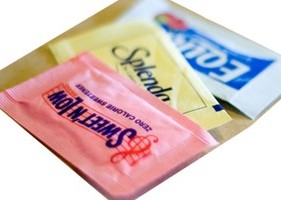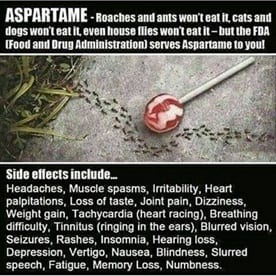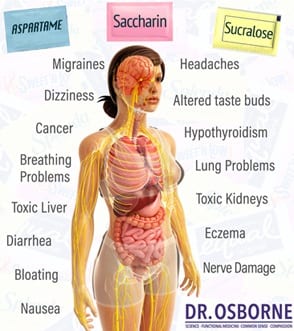Revealing research on Artificial Sweeteners
Blue indicates link
What are artificial sweeteners:

A sugar substitute is a food additive that provides a sweet taste like that of sugar while containing significantly less food energy than sugar-based sweeteners, making it a zero-calorie or low-calorie sweetener.
Three artificial sweeteners: Equal (aspartame), Sweet’N Low (saccharin), and Splenda (sucralose)
- Aspartame: 200 times sweeter than table sugar. Aspartame is known under the brand names NutraSweet, Equal, or Sugar Twin.
- Acesulfame potassium: 200 times sweeter than table sugar. Acesulfame potassium is suited for cooking and baking and is known under the brand names Sunnet or Sweet One.
- Advantame: 20,000 times sweeter than table sugar, suited for cooking and baking.
- Aspartame-acesulfame salt: 350 times sweeter than table sugar, and known under the brand name Twinsweet.
- Cyclamate: 50 times sweeter than table sugar. Cyclamate is suited for cooking and baking. However, it’s been banned in the US since 1970.
- Neotame: 13,000 times sweeter than table sugar. Neotame is suited for cooking and baking and is known under the brand name Newtame.
- Neohesperidin: 340 times sweeter than table sugar. It is suited for cooking, baking, and mixing with acidic foods. It is not approved for use in the US.
- Saccharin: 700 times sweeter than table sugar. It’s known under the brand names Sweet’N Low, Sweet Twin, or Necta Sweet.
- Sucralose: 600 times sweeter table sugar. Sucralose is suited for cooking, baking, and mixing with acidic foods. It’s known under the brand name Splenda.
Aspartame:

It is made from two amino acids, while sucralose is a modified form of sugar with added chlorine. … Diet Coke still uses aspartame
Widely reported studies have shown a correlation between cancer and aspartame consumption in rats — but not in humans. Diet Pepsi last year, PepsiCo said it stood behind the safety of aspartame.
Under the trade names Equal, NutraSweet, and Canderel, aspartame is an ingredient in approximately 6,000 consumer foods and beverages sold worldwide, including (but not limited to) diet sodas and other soft drinks, instant breakfasts, breath mints, cereals, sugar-free chewing gum, cocoa mixes, frozen desserts, gelatin desserts, juices, laxatives, chewable vitamin supplements, milk drinks, pharmaceutical drugs, and supplements, shake mixes, tabletop sweeteners, teas, instant coffees, topping mixes, wine coolers, and yogurt. It is provided as a table condiment in some countries. Aspartame is not recommended for use in baking as it breaks down and loses much of its sweetness
Aspartic Acid (40 percent of Aspartame) Dr. Russell L. Blaylock, a professor of neurosurgery at the Medical University of Mississippi, recently published a book thoroughly detailing the damage that is caused by the ingestion of excessive aspartic acid from aspartame. Remember this is 40% of what you drink. Blaylock makes use of almost 500 scientific references to show how excess free excitatory amino acids such as aspartic acid and glutamic acid (about 99 percent of monosodium glutamate or MSG is glutamic acid) in our food supply are causing serious chronic neurological disorders and a myriad of other acute symptoms.
Too much aspartate or glutamate in the brain kills certain neurons by allowing the influx of too much calcium into the cells. This influx triggers excessive amounts of free radicals, which kill the cells. The neural cell damage that can be caused by excessive aspartate and glutamate is why they are referred to as “excitotoxins.” They “excite” or stimulate the neural cells to death.
According to WebMD, “Some people have reported that aspartame gives them headaches or dizziness or affects their moods, but studies haven’t linked those symptoms to aspartame. If you have phenylketonuria (PKU), a rare metabolic disorder, avoid aspartame, because it contains phenylalanine. Any product containing aspartame has a warning label about that.”
For some who have health problems that are listed in the warning for aspartame usage, aspartame may not be the right choice for you. As a result, the Mayo Clinic advises making sure that you always consult with your doctor first, before ingesting anything that may have an impact on your health. Did I read that right? That is so common sense, why is it necessary to list it when it comes to aspartame? Artificial sweetness for thought.
Aspartic acid from aspartame has the same deleterious effects on the body as glutamic acid isolated from its naturally protein-bound state, causing it to become a neurotoxin instead of a non-essential amino acid.
Aspartame in diet sodas or aspartame in other liquid form is absorbed more quickly and have been shown to spike plasma levels of aspartic acid.
Aspartic Acid
The Alleged Side Effects of D-Aspartic Acid
Many D-aspartic acid side effects rumors originated in forums and product reviews. While many users said they didn’t have any problems while using D-aspartic acid, some users claimed the following side effects:
- Acne
- Headache
- Diarrhea
- Mood Swings
- Depression
- Pregnancy and breastfeeding: Not enough is known about the use of aspartates during pregnancy and breast-feeding. Stay on the safe side and avoid use.
Glutamic acid:
It is an α-amino acid that is used by almost all living beings in the biosynthesis of proteins. It is non-essential in humans, meaning the body can synthesize it.
Pepsi to Drop Aspartame From Diet Pepsi.
April 24, 2015 7:41 p.m. ET
PepsiCo Inc. said Friday it would remove the sweetener aspartame from Diet Pepsi, seeking to address consumer concerns about the artificial additive and reverse slumping diet soda sales. Instead, PepsiCo Inc. is going to introduce, “Sucralose”, another controversial artificial sweetener.
Sucralose:
Accidentally discovered by U.K. scientists while they were developing new insecticides, remains the biggest sugar substitute on the market, according to retail tracking service Infoscan Reviews and Information Resources, Inc. Aspartame is made from two amino acids, while sucralose is a modified form of sugar with added chlorine. One 2013 study, found that sucralose may alter glucose and insulin levels and may not be a “biologically an inert, (not chemically reactive) compound.”
“Sucralose is almost certainly safer than aspartame,” says Michael F. Jacobson, executive director at the Center for Science in the Public Interest, a Washington, D.C. Diet Pepsi will still contain another FDA-approved artificial sweetener — acesulfame-potassium, or ace-K — which some researchers have said needs further testing and research.
What is Saccharin?
Saccharin is a non-nutritive sweetener that is used in products in many countries. It has not been allowed in Canada as a food additive since the 1970s.
HEALTH REPORTER PUBLISHED MAY 27, 2014,
UPDATED MAY 12, 2018,
After years of discussion, Health Canada quietly decided last month to permit the sweetener in gum, pop, and other non-alcoholic beverages, frozen desserts, alcoholic liqueurs, fruit spreads, and other products. The news comes amid growing concern over the serious health risks of consuming too much sugar, including heart disease, stroke, and premature death.
Personal Note:
Is the controversy worth the risk? I am searching all over the place to find out something conclusive there are artificial sweeteners out there that are risky to your health. Once these substitutes were said to cause cancer and neurological disorders but it is 2019 and I am finding it irritating to see the huge big question mark.
Why is this so? I was under the impression we had advanced technologically far enough to make a conclusive statement as to whether these artificial sweeteners cause a health hazard. There is the notation that anything in moderation is OK. A lot of these soft drinks are addictive. I know I was addicted to Coca-Cola for many years and when I decided to kick the habit I suffered from shakes, jitters, and a few other uncomfortable side effects.
What’s Next?
Saccharin, like aspartame, sucralose, and acesulfame potassium, is an artificial sweetener. It’s been around since the 1800s and became a popular alternative to sugar throughout the 20th century because it was less expensive and had no calories.
However, the perception of saccharin changed after the publication of research suggesting saccharin could cause cancer – specifically, studies found it increased the incidence of bladder cancer in rats. Major restrictions on the sale and use of saccharin followed.
Since then, more studies have been done that question the link between saccharin and cancer. The studies have shown that the mechanism that causes bladder cancer in rats isn’t applicable to humans.
Not everyone is happy to see saccharin back in Canada. Lisa Lefferts, a senior scientist with the Washington-based Center for Science in the Public Interest, argues that anything that may cause cancer in lab animals shouldn’t be deemed safe for humans.
The advocacy organization has, for many years, spoken out on the potential risks of artificial sweeteners and urges consumers to avoid saccharin. The mechanism that causes bladder cancer in rats may not apply to humans, but that doesn’t mean saccharin doesn’t pose a risk.
Artificial sweeteners are attractive because they let us eat and drink sweet treats without the caloric guilt. For people with diabetes, they also allow the freedom to eat foods that would otherwise be off-limits.
But, like many things in life, the idea that most of us can have our sugar-free cake and eat it too is simply too good to be true. Studies show that people who consume foods and beverages sweetened artificially are actually driven to eat more, which could be because the sweeteners don’t make the body feel full, or because the sweetness promotes the desire to eat.
Stevia:
Stevia is known to be a natural, no-calorie sweetener, made from a plant indigenous to South America. It has been around for centuries and now makes its appearance in sodas and many sports drinks. This substitute is also available in table-top packets, liquid drops, dissolvable tablets, as well as baking blends.
Breaking down Stevia
Older animal studies show that high doses of Stevie may be toxic to the kidneys and reproductive system, and could even mutate genes. That’s why the FDA doesn’t allow unrefined or whole-leaf Stevie in foods, despite the fact that South Americans have consumed the plant for centuries. But newer data on stevioside and rebaudioside A—the purified extracts—does not show evidence of toxicity (though it’s worth noting that some of this research was funded by companies like Coca-Cola and Cargill, the maker of Truvia).
In 2008, the FDA awarded its first Generally Recognized as Safe (GRAS) status to these extracts, which have been approved for use and sold in Europe, Canada, France, New Zealand, and Japan, where it’s been on the market for decades without any major safety issues. The WHO and UN’s Joint Expert Committee on Food Additives have also ruled them to be safe in moderation.”
Anything that is artificial is exactly what. It is not the real thing and has been chemically modified for profit. Sorry, once again that is my opinion.
Natural alternatives for the use of aspartame include honey, maple syrup, agave nectar, fruit juice, and molasses. In short, individuals who experience adverse side effects should play it safe and avoid Aspartame, but most studies seem to conclude that it’s safe for those who are able to enjoy it in moderation.
CTV News
August 29/2019 at 1:31 PM
An Ontario family was devastated when their beloved Great Dane Gracie died after eating four packages of chewing gum—and are warning others to be careful with products containing an artificial sweetener that may have played a role in the dog’s death
Jennifer Watt, from Schomberg, told CTV News Toronto that Gracie was a wonderful dog for her three children.
“She was a great family pet. She would play with her brother and let the kids climb all over her” said Watt.
Watt says she had purchased 12 packs of chewing gum and had wrapped it as part of a gift. Gracie found the present hidden under a bed, ripped it open, and then ate four packages of Pur chewing gum, which is sweetened with xylitol, an artificial sweetener.
“Within a few minutes, she was able to get from upstairs to downstairs, and then she collapsed and went unconscious.”
Gracie weighed about 150 pounds and Watt says her husband scooped her up in his arms and took her to the local veterinary clinic, which tried to stabilize her.
The chewing gum contained xylitol, a sugar substitute that is toxic to dogs and cats. The family later took Gracie to an animal hospital and despite more than $7,000 worth of medical tests and treatment; she died of liver failure 48 hours later.
“So a couple of packs of gum cost us with the fees of the veterinarian and replacing the dog close to $10,000,” said Watt.
This isn’t the first time a beloved pet became ill after consuming a product with artificial sweeteners.
CTV News Toronto spoke with Arnie Charlton, of Windsor, last month when his cockapoo Lexi almost died. The dog quickly snatched a single piece of gum that was dropped on the floor by his granddaughter. It also contained the artificial sweetener xylitol.
The dog became sick and also had to be rushed for veterinary care.
Xylitol is also being used as a sweetener in baked goods, toothpaste, and peanut butter.
“Something like peanut butter seems like an innocent way to give medication, but if it’s peanut butter that contains this artificial sweetener that could be fatal, so read labels before you give your pet any substance,” said Melanie Couleter with the Windsor Essex County Humane Society.
Watt has two other Great Danes now. Her dog Gracie died a few years ago, but she says her family never went public with what happened.
Watt says after seeing more of these artificial sweeteners on the market containing xylitol she decided to contact CTV News Toronto to tell her story.
“I’m just trying to prevent other families from having to go through what we went through,” Watt said.
So what is this Artificial Sweetener Xylitol?
Xylitol is a naturally occurring alcohol found in most plant material, including many fruits and vegetables. It is extracted from birch wood to make medicine.
Xylitol is widely used as a sugar substitute and in “sugar-free” chewing gums, mints, and other candies.
Dog owners should know that xylitol can be toxic to dogs, even when relatively small amounts of candies are eaten. If your dog eats a product that contains xylitol, it is important to take the dog to a veterinarian immediately.
It is dangerous to dogs. Personally, if this sweetener was the contributor to the death of a 150-pound Great Dane I would be really afraid of having it anywhere near my children.
Please, please be careful when it comes to artificial sweeteners.

Some of the many side effects when using artificial sweeteners
The Dangers of Artificial Sweeteners Images and Information: Please click on the links below.
The dangers of artificial sweeteners confirmed
CNN Report on Artificial Sweeteners
Videos, images, and further information
Please stay healthy. Go the natural way for the best benefits. I have dedicated my site to alternatives and healthy lifestyles.
Thank you for visiting,
Your comments are welcome,
Michael

Hi Michael and what a great article.
I grew up in the country in New Zealand and both my parents were very strict when it came to sweet things and all my life I have avoided the sweet stuff. One day my friend suggested I try sucryl instead of a wee bit of sugar and I felt ill as soon as I tasted it I also tried a diet coke once and threw it in the bin as it tasted terrible because of the artificial sweeteners and reading through this post, I feel that a lot of these products are doing more harm than good
Just my 20 cents worth Michael
I love how informative you are with your posts and have bookmarked to visit frequently
Go well
Hi Vicki, thank you for your comments and your personal experience. Very much appreciated.
I really thought writing this post would be pretty basic, but I was led down several different avenues almost getting into these energy drinks
It just does not make any sense to me why after all these years the jury is still out. My gosh if some of these sweeteners have shown dangerous signs of toxicity in rats, enough to cause neurological disorders and even cancer. I certainly would not want it my body. I am having a tough enough time as it is.
Thank you very much Vicki,
Michael
Hi Michael, thanks for this post, its very informative. I don’t seem to get one point out here, if the sweeteners poses a risk to our health, then why should they be allowed in the first stance. I agree with Lisa Lefferts that anything g that’s harmful to lab animals should not even be prescribed for humans. Henceforth, I will never take aspartame again. Thanks for conducting this much research to sensitize us all
Hi RoDarrick, thank you very much for your comments. Much appreciated.
I do not get the point either. Major soda companies and anyone promoting these artificial sweeteners do pay a substantial amount of money to research companies and favorable charities, so I do wonder about the accuracy.
This research drove me up the wall, it even branched off into energy drinks which I may cover down the line.
You are right and so is, Lisa Lefferts for making a very logical statement. I did go to a couple of variety stores with a magnifying glass and a notepad to mark down what was in these drinks. I was told to either buy them or leave. Further to my disappointment here in Canada the warm weather is just starting and I could not find too many ants.
Bottom line is, if after all these years if the scientific community has not made a conclusion I would tend to stay away from these sweeteners.
Thank you,
Michael